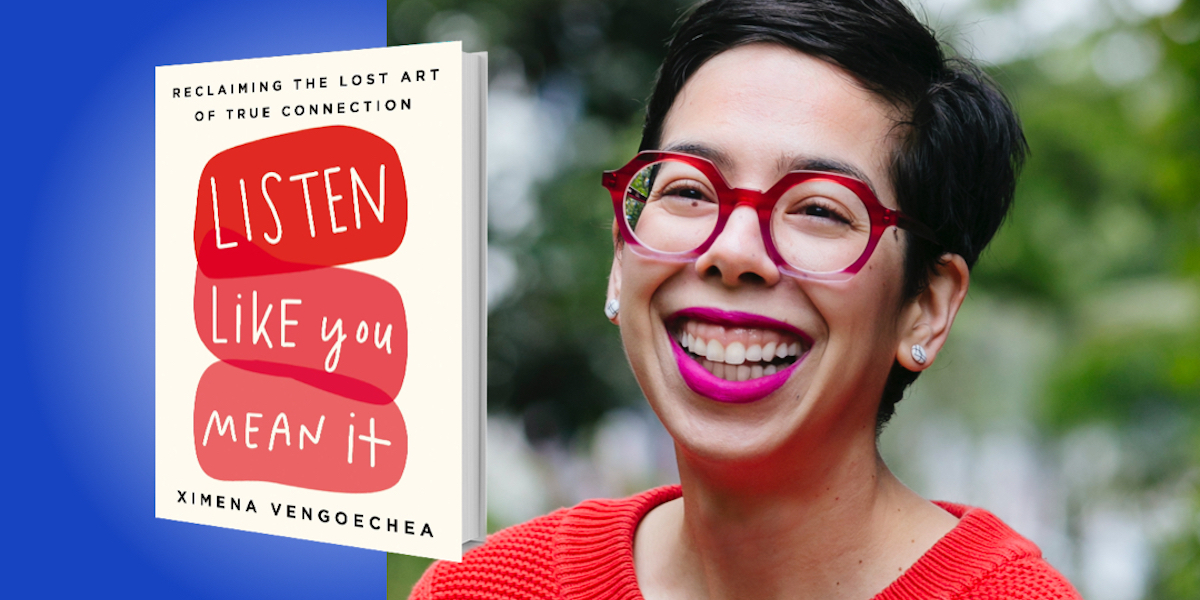Ximena Vengoechea is a writer, illustrator, and a user researcher at companies like Pinterest, Twitter, and LinkedIn. She is tasked with understanding people’s needs, motivations, and perceptions in order to help build better products. Through this work she has extensive experience interviewing people, asking the right questions, and listening like she means it.
Below, Ximena shares 5 key insights from her new book, Listen Like You Mean It: Reclaiming the Lost Art of True Connection (available now from Amazon). Listen to the audio version—read by Ximena herself—in the Next Big Idea App.
1. Most of us are not really listening.
Most of us spend our time in conversation in what I call surface listening mode—we hear enough of a conversation to be polite, or at least nod and smile, but we don’t get much of the underlying meaning. Instead, we’re often distracted, or thinking up our own response, or are ready to move our own agenda along without questioning if our conversation partner is with us. Surface listening does little to strengthen our relationships because we don’t really hear each other, so we can’t get to know someone or build trust with them.
Empathetic listening is what happens when we listen beyond the surface. We go beyond the literal (what’s being said), past the subtext (what is meant), and go all the way down to the emotions (what is felt). This is where the strength of our relationships and real human connection occurs.
To get deep, you can bring in what I call a listening mindset. There are three main qualities to this mindset: humility (being ready to learn, not assuming we have all the right answers, and not judging others), curiosity (exploring someone’s driving motivation or interest in a topic), and empathy (trying to understand what the other person is experiencing). Each of these qualities helps us center the conversation away from ourselves and toward the other person, in order to understand them.
2. Conversations contain hidden needs.
We often enter into conversation not thinking much of it—we just show up and participate in the way that feels most natural. But what if you knew that in every conversation, there is a need waiting to be uncovered? You might listen differently.
“When we realize that hidden needs exist in every conversation, we can listen with intention, and try to decipher what that need is and how we might meet it.”
The truth is, humans are social beings, and there’s often something we want or need from our interactions with others—sometimes conscious, sometimes not. Say a colleague vents to you about a difficult boss. Although it might just sound like a rant, there’s a need they are expressing. They might be looking for solidarity and validation from a fellow colleague to agree with them that their boss is particularly prickly, and reassure them that it’s not their fault. Or perhaps they are in need of someone to give them a pep talk, or even a potential set of solutions for how to manage the situation. Maybe they need your witty sense of humor to lighten the topic and the mood. The point is, there’s a reason they are bringing this story to you—there’s a hidden need at play that they are hoping you can help meet.
Of course, it would be much easier if people told us what they needed, but how often does a friend, coworker, or partner say “I need to be encouraged right now”? Sometimes we don’t know what we need, and other times, even when we think we are asking for what we need, we are often indirect. When we realize that hidden needs exist in every conversation, we can listen with intention, and try to decipher what that need is and how we might meet it.
3. Each of us has a particular filter we tend to listen through. Sometimes it’s the perfect fit, but sometimes it’s not.
When we’re not paying attention, we tend to use default listening mode. It’s how we instinctively listen, informed significantly by our personality and early relationships. When we don’t match our listening mode to the moment, we can miss what’s really needed and inadvertently push our conversation partner away. There are eleven modes to be aware of, two of which I’ll highlight here.
One default listening mode is the problem-solver. This group tends to hear conversations as a problem to be solved—which is great when there truly is something that needs fixing, but not so great when your conversation partner isn’t looking for solutions. When we stick to this listening mode, we might miss that our friend is venting as a means to express themselves, without needing you to change how they feel. The same mode can cause hurdles at work, like if we give advice on next steps when they are not requested, and end up making an employee feel micromanaged.
“No matter the question you ask, remember that silence is your friend.”
Another popular default listening mode is the identifier. Identifiers are great at finding commonalities between their conversation partner’s experience and their own, which can make others feel less alone. If someone is sharing a tough situation about a spouse, an identifier might share a tough experience they’ve had, too, as a way of showing that they understand. Sometimes this is the right approach, but other times it can feel dismissive. We might get upset that they’ve compared a spousal conflict with, say, a managerial one, or feel like they’re changing the subject and putting the focus on them when we haven’t finished expressing our thoughts on a difficult topic. Even though identifying is a well-intentioned listening mode, it can backfire if you don’t pay attention to what’s needed in a particular moment.
Bottom line: You want to discover what your default listening mode is so that you can determine whether it’s relevant in conversation, lean into it if it’s called for, and adapt if it’s not.
4. Asking the right questions can deepen a conversation.
Ever ask a question and hit a dead end, one-word answer? We often use what I call disconnecting questions without realizing it—questions that can be answered in one word, or that lead to a particular response. Let’s say a coworker has a big presentation coming up. Without giving it much thought, you ask them, “Are you nervous about tomorrow’s presentation?” Sounds harmless enough, but by leading with the idea of nervousness, we might have inadvertently created added pressure for our peer to perform, or even seeded doubt that they aren’t sufficiently prepared for the big event, when what we really want to know is how they feel about it. In general, think twice before you ask a question that starts with “Do,” “Is,” or “Are,” as these are often closed-ended, and can therefore narrow a conversation.
A better choice is to use a connecting question. They usually begin with “how” or “what,” and are the perfect starting point in conversation. For example, “How do you feel about tomorrow’s presentation?” removes our bias or perception and can lead to a richer, truer response. You can also follow up with smaller connecting questions that gently nudge continued sharing. That might sound like, “Say more about that,” or “What else?” Small nudges, big results.
“We all have personal blockers to staying present and empathetic in conversation, but when we get to know ourselves, we can more easily be there for others.”
Finally, no matter the question you ask, remember that silence is your friend. For many of us, if a lull comes up in conversation, we quickly become uncomfortable. We’ve learned that conversations are lively and dynamic, and a pause in the conversation is awkward. So we rush in to fill the void—but silence is a powerful lever. It allows the other person to take up more space, even if it’s initially uncomfortable. Sometimes your conversation partner is just thinking through their response, not uninterested or bored. Paired with connecting questions, a little bit of silence can go a long way to deepen a conversation.
5. Empathetic listening requires self-awareness.
When we think of listening, we often think about focusing our attention outward on our conversation partner, in order to really hear them. That’s part of the story, for sure, but perhaps even more crucial is drawing our attention inward to understand ourselves, too. The challenges we face when listening are personal and unique to each and every one of us. The things that prevent you from staying present, staying humble, staying empathetic, and staying curious in conversation will be different from the things that prevent me from doing the same. Whether you’re in a good mood or stressed out, are a morning person or night owl, are feeling emotionally charged about a topic or able to stay neutral, can all impact your ability to listen with empathy.
That’s why self-awareness is so key to our listening practice. If you are in tune with what you are experiencing during a conversation—mentally, emotionally, and physically—you can better manage your responses. If you know the kind of environment or circumstances in which you do your best listening, you can architect conversations in support of that, or acknowledge when you might not be at your best. If you’re able to recognize when a conversation sets off an emotional response and begins to hinder your rational thinking and listening, you can take care to ground yourself or pause to regroup. We all have personal blockers to staying present and empathetic in conversation, but when we get to know ourselves, we can more easily be there for others.
To listen to the audio version read by Ximena Vengoechea, download the Next Big Idea App today:































